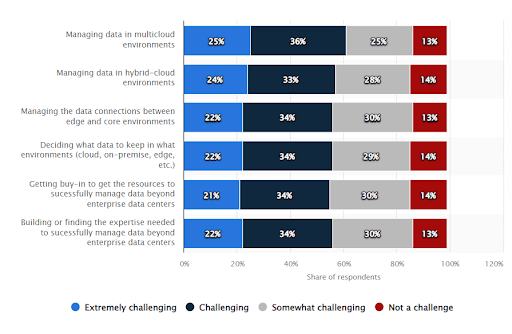
1. Humongous Data Storage volume
One challenge is the sheer volume of data that needs to be stored. Suppose you’re trying to manage all your data manually using traditional storage devices. In that case, it can take a lot of time and effort and lead to data fragmentation and incompatible formats. This data fragmentation and lack of data portability make it difficult for employees or stakeholders to search and access the information when needed, which can impact productivity and customer service. The amount of data (especially unstructured data) generated in the world is increasing exponentially, and there is no sign of slowing down. Managing this crazy volume, sorting through, and storing this data in different silos is one of the biggest challenges in data management. Worldwide data is expected to hit 175 zettabytes by 2025, representing a 61% CAGR.
2. Growing Data Types and Data Sources
Modern digitally-enabled organizations must store and manage data of different types originating from various sources. Broadly these include structured and unstructured data, with the latter constituting about 80% of the total data volume. And the data storage management conundrum spans departments such as finance, accounts, operations, customer service, HR, and more. Each data type and source needs specific treatment while requiring an easy console to search and access this information.
- Where should each data type be stored?
- In what format should data be stored?
- What is the data retention policy for each category?
- What is the disposal policy for aging or out-of-use data?
- What are the policies governing access to this data?
3. Too Many Data Storage Mediums
4. Legacy IT Architectures
5. Data Corruption
6. Predictability of Data Needs
7. Data Automation
8. Data Governance:
A set of rules and regulations are required to manage an enterprise’s data, especially an enterprise that generates a large volume of data. Many enterprises lack this. Enterprises must create a framework to manage their data. Some elements of the framework include:
- What data needs to be deleted
- What information needs to be archived and for how long
- What information needs to be permanently stored
- Which employee gets what level of access, and more.
9. Adhering to Industry Compliances
10. Data Security and Recovery
11. Data Storage Management Costs
12. Privacy Regulations and Laws
Governments put these regulations in place to protect citizens from having their personal information stolen or used without their consent or knowledge. Organizations that collect and store critical and personal information from their customers must comply with these regulations and laws. Some of these laws and regulations tenets are data residency, data encryption, data classification, the ability to locate data with critical templates like PII or financial details, adhering to the consumer’s right to delete their data from your systems, and more. Without investing heavily in solution building and an operational team to maintain and deliver on these tenets, most organizations end up being on the wrong side of the law. New-age companies are seeking cutting-edge cloud solutions to help them protect their customer’s critical data while quickly adhering to regulations and laws on data privacy. Related: GDPR Shared Responsibility model










